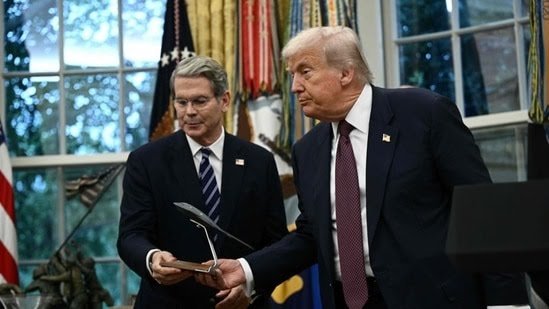Tensions between the United States and India have escalated following the imposition of a 50% tariff by the Trump administration on Indian goods. This punitive measure, set to take effect soon, is a direct response to India’s significant increase in purchases of Russian oil since the start of the war in Ukraine. According to US Treasury Secretary Scott Bessent, this isn’t just a matter of energy policy, but one of “profiteering” and “arbitrage.” Bessent claims India is making billions by buying discounted Russian crude and then reselling refined products at a substantial profit, a practice he deems “unacceptable.”
Prior to the conflict in Ukraine, India’s oil imports from Russia were minimal, less than 1%. This figure has now skyrocketed to 42%, making Russia a primary oil supplier for India. The U.S. official’s comments underscore a key difference in how the Trump administration views India versus China. While China also imports Russian oil, its pre-invasion imports were already significant (13%) and have only seen a modest increase to 16%. Bessent argues that China’s diversification of oil sources makes its situation “suboptimal,” but not a blatant act of profiteering like India’s. This distinction is at the heart of the U.S. decision to penalize India but not China.
The U.S. decision to impose these tariffs has not gone unnoticed on the world stage. Russia, a key ally and major trading partner of India, has vocally supported New Delhi and warned the U.S. against using “illegal threats” against its trading partners. This intervention highlights the complex geopolitical dynamics at play. The tariffs not only strain India-U.S. relations but also solidify the strategic and economic ties between India and Russia. As the deadline looms, India has shown some willingness to de-escalate, temporarily suspending an 11% import duty on cotton, a move seen as a gesture to Washington regarding its agricultural concerns.
As Top US Official Explains Why China Escaped Tariffs, Points to India’s Role in Reselling and Profiteering from Russian Oil, On the domestic front, the tariffs have put the Indian government in a difficult position. Prime Minister Narendra Modi has stated that India is “prepared to pay a heavy price” and will not compromise on the interests of its farmers, a reference to ongoing trade deal negotiations that have been stalled by agricultural market access issues. This stance signals that despite the economic pressure, India is determined to protect its domestic interests and assert its right to make independent trade decisions. The arrival of Chinese Foreign Minister Wang Yi in New Delhi adds another layer to this geopolitical puzzle, as he called for expanded cooperation between India and China to counter what he termed “overwhelming bullying” and challenges to free trade. This convergence of interests between two often-rival nations underscores the gravity of the U.S. tariffs and their potential to reshape regional alliances.
The current diplomatic and economic standoff between the U.S. and India, sparked by Washington’s 50% tariffs, underscores a fundamental clash of national interests in a rapidly evolving geopolitical landscape. While the Trump administration frames its actions as a necessary measure to pressure Russia and prevent India from “profiteering,” New Delhi views it as an unjustified and unilateral act that disregards its sovereign right to ensure energy security for its 1.4 billion citizens. This divergence in perspective highlights the complexities of global alliances, where economic incentives often supersede political allegiances.
The tariffs are poised to have a significant impact on India’s economy, with key labour-intensive sectors like textiles, gems and jewellery, and seafood facing a substantial blow to their competitiveness in the American market. India’s government has pledged to support its domestic industries and farmers, but the cancellation of a U.S. trade delegation visit to New Delhi signals a difficult road ahead for resolving the dispute through negotiation. This economic pressure also pushes India closer to its existing strategic partners, with Russia offering to increase trade and welcome Indian exports into its markets, and China’s foreign minister visiting New Delhi to advocate for greater cooperation against perceived Western “bullying.” This convergence of interests could lead to a stronger India-Russia-China axis, a development with significant implications for global power dynamics.
The U.S. position also faces scrutiny for its perceived double standard. India argues it is being unfairly singled out for a practice that other major economies, including some in the EU and even the U.S. itself, have engaged in. The Biden administration, for instance, had reportedly encouraged India to buy Russian oil to prevent a global price surge. This historical context complicates the Trump administration’s current stance and fuels India’s assertion that its actions are guided by market forces and national security, not an attempt to undermine Western sanctions.
The trade dispute is more than just a disagreement over tariffs and oil; it’s a test of the India-U.S. strategic partnership. India’s resolute stance, backed by its economic and energy needs, demonstrates its commitment to an independent foreign policy. Whether this path leads to a fundamental realignment of global trade routes or forces a diplomatic resolution remains to be seen. The coming weeks, as the tariffs take effect, will be a critical period for both nations to navigate this high-stakes standoff and determine the future trajectory of their relationship.

